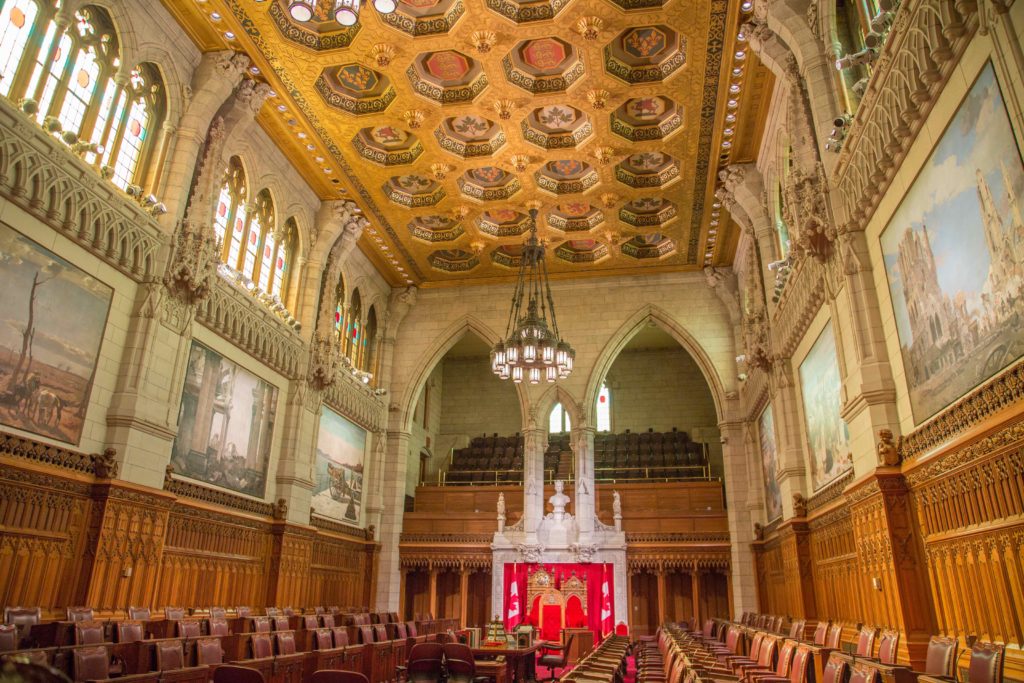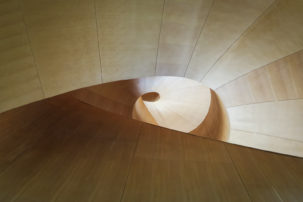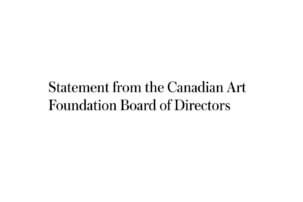A national artist laureate initiative that seemed to have fairly wide support in government has failed.
Bill S-234, An Act to amend the Parliament of Canada Act (Parliamentary Visual Artist Laureate) was introduced in the Senate in December 12, 2016. After some discussion, it passed there easily on May 8, 2018. But it didn’t win the necessary support in the House of Commons on November 30, 2018—and was promptly dropped.
“We are obviously disappointed that after two years of work, especially in the Senate, that the bill died the way it did,” CARFAC executive director April Britski tells Canadian Art. “It’s important for Canadians to have a position like this.”
Those involved in the initiative—including senators, artists, and arts-service organizations—aren’t giving up.
A blog post released yesterday by the Visual Arts Alliance is headlined “Canada Needs A Visual Artist Laureate.” (The Visual Arts Alliance is “a consortium of national visual, media, and craft arts service organizations comprised of artists, curators, art museums, artist run centres, and art dealers,” encompassing a wide range of perspectives and interests.) The blog post points out that Canada has run a successful Parliamentary Poet Laureate position since the early 2000s, and contends that visual artists deserve the same.
Supporters of the artist laureate idea also say that the failure of the bill in the House of Commons was largely a technical issue, rather than a matter of deeply held opinion, and that it could pass on another run.
What Was Proposed
Nova Scotia artist Peter Gough played a major role in getting the artist laureate bill started in the first place. He brought the idea to Senator Wilfred Moore in fall of 2015. Moore then began shepherding it into the Senate.
“My motivation for wanting to see an artist laureate bill passed is to promote the arts in Canada,” Peter Gough tells Canadian Art. “I know that there are a lot of art groups around, like the Canadian Arts Coalition or the Arts Alliance or CARFAC, but there is not one single, like, lightning rod or individual that all of these groups can focus through—one individual who can be a champion for the arts in this country.”
Bill S-234 proposed that the visual artist laureate would have a mandate “to promote the arts in Canada, through Parliament, including by fostering knowledge, enjoyment, awareness and development of the arts.” The laureate would have a term of no more than two years. They would chosen from a shortlist prepared by a committee that included the chair of the Canada Council and the director of the National Gallery of Canada, among other officials. (The speakers of the Senate and the House would make the final choice.)
Compensation and budget for the artist laureate, when discussed in a Senate committee in 2017, was proposed to mirror that of the poet laureate. For the poet, that currently comprises “an annual stipend of $20,000, up to $13,000 in travel expenses annually and a budget for programming, administrative expenses and translation/adaptation of works into Canada’s second official language.”
What Happened to the Initial Bill
Senator Patricia Bovey, a sponsor of the artist laureate bill in the Senate after Wilfred Moore’s retirement, was a public-gallery director for many years. She calls the failure of the bill in the House of Commons “a technical issue.”
Certainly there was a strange turn of events after the bill passed the Senate in May 2018: Liberal MP Dan Vandal of Saint Boniface–Saint Vital began to sponsor S-234 in the House of Commons, but was unable to continue that in fall 2018 after becoming a parliamentary secretary. No other MP stepped forward to sponsor it by time of its second reading—which happened to be on a wintry Friday right before lunchtime and a weekend recess.
At that point, near midday on November 30, 2018, NDP MP Marjolaine Boutin-Sweet of Hochelaga suggested the House attempt to pass the artist laureate bill with unanimous consent. “Since this bill is totally uncontroversial, I am hoping we can pass it at all stages without using any more of the House’s most precious resource, which is time,” said Boutin-Sweet. But some MPs (it’s not recorded who) disagreed, and the bill failed to pass—and was dropped.
The Case for Reviving the Idea Now
Several stakeholders say the artist laureate bill is still worth fighting for.
“The visual and media arts contribute to the public understanding of our national culture and heritage, and the creation of this position would put us on an equal footing with our colleagues in the literary arts,” contends the blog post yesterday from the Visual Arts Alliance.
April Britski of CARFAC says that while deceased Canadian artists like Emily Carr and Tom Thomson are widely known, as well as living Canadian writers like Margaret Atwood and Michael Ondaatje, the same is not true of living artists—and a laureate position could change that.
“Many people don’t know who living visual artists are in Canada, so this could be helpful in terms of raising the profile,” Britski says.
Prior to becoming an independent in the Senate in late 2016, Senator Patricia Bovey was director of the Art Gallery of Greater Victoria for 19 years and director of the Winnipeg Art Gallery for 5 years. Bovey was also sponsor of Bill S-234 in the Senate in 2017 and 2018. Her support for the bill seems to dovetail with her longtime belief in the arts.
“Visual artists quite regularly bring issues of social concern to the public forum long before the rest of society catches up with it,” says Senator Bovey of her belief in the National Artist Laureate bill. “The arts are among the most powerful tools we have for human understanding and social change.”
Though the field of artist awards has grown in Canada in recent years with the Sobey Art Award, the Scotiabank Photography Award and other accolades, all the people interviewed for this story stated—as with the contrast between a Griffin Poetry Prize win and assuming the Poet Laureate role—that appointing an artist an officer of the Library of Parliament for two years makes possible a different level of dedicated national advocacy and profile.
What Could be Next
In recent days, Peter Gough, the artist who initiated the inception of Bill S-234, has been calling and emailing politicians from various parties to continue advocacy on the artist laureate front.
Gough was diagnosed with cancer in October 2018 and had hoped to see the bill passed in his lifetime. “Now, I may not see this come to fruition,” Gough reflects. But he continues to advocate.
Senator Bovey, for her part, is hoping to revive the artist laureate initiative by all means at her disposal—and as quickly as possible.
“I’m ready to bring it back to the Senate as soon as possible,” says Senator Patricia Bovey of Bill S-234. She tells Canadian Art, “We’re already working on how that’s going to happen.”
“There may be a procedural rule that I may not be able to bring it [the bill] back until after the next Parliament is formed,” says Senator Bovey. “But I’m ready to roll…. I think it’s a very important piece of legislation.”
The existence of the poet laureate position already does make a case for a visual artist parallel, Bovey states.
And there is, perhaps, a silver lining to the recent turn of events around the artist laureate position in terms of raising public profile for the effort, says April Britski of CARFAC.
“Not a lot of people knew this [the artist laureate initiative] was happening, so maybe it’s a good thing that this [recent turn] may bring public attention” to the issue, says Britski.
Looking ahead, Britski says, “we may ask members and others to support the bill, when it is reintroduced, by contacting their local representatives.”
An Artist-Laureate Legislation Timeline
2001: Canada creates a Parliamentary Poet Laureate position as part of the Parliament of Canada Act. The poet laureate legislation originated as a private member’s bill brought by Senator Jerry Grafstein. It proposes a term of two years for poets to “encourage and promote the importance of literature, culture and language in Canadian society.” A small stipend and budget is allotted.
Fall 2015: Nova Scotia artist Peter Gough approaches Halifax West MP Geoff Regen with proposal for National Artist Laureate—similar to that of the Poet Laureate position but for visual arts. Regen recommends Gough contact Liberal Senator Wilfred Moore of Nova Scotia, who helped NSCAD establish a community arts program in Lunenberg in 2014.
December 12, 2016: Bill S-234 An Act to amend the Parliament of Canada Act (Parliamentary Visual Artist Laureate), sponsored by Senator Wilfred Moore, has its first reading in the Senate.
January 14, 2017: Senator Wilfred Moore retires. Stewardship of Bill S-234 in the Senate is taken up by independent Senator Patricia Bovey of Manitoba. Bovey is longtime public gallery director who was appointed to the Senate on November 10, 2017.
June 8, 2017: Bill S-234 has its second reading in the Senate, and it is referred to committee.
December 13, 2017: Bill S-234 is discussed by the Standing Senate Committee on Social Affairs, Science and Technology. Senator Bovey, retired Senator Moore and Canada Council chief of staff Joanne Larocque-Poirier speak in its support and answer questions about it from other senators.
December 14, 2017: Committee report on the Bill S-234 is presented with amendments.
April 19, 2018: Committee report on Bill S-234 adopted by the Senate.
May 8, 2018: Bill S-234 passes its third reading in the Senate.
June 20, 2018: Bill S-234 has its first reading in the House of Commons. It is introduced there by Liberal MP Dan Vandal of Saint Boniface–Saint Vital.
September 1, 2018: MP Dan Vandal becomes parliamentary secretary to the Minister of Indigenous Services. As a parliamentary secretary, he can no longer sponsor Bill S-234 or other similar bills.
November 30, 2018: Bill S-234 is due to have its second reading in the House of Commons. As no other MP has stepped forward to sponsor the bill, NDP MP Marjolaine Boutin-Sweet of Hochelaga suggests the House attempt to pass the artist laureate bill with unanimous consent. Some MPs vote yes, and others vote no. (Which MPs voted which is not recorded in hansard.) The bill is therefore dropped.
February 10, 2019: The Visual Arts Alliance, a consortium of national visual, media, and craft arts service organizations comprising artists, curators, art museums, artist-run centres and art dealers, posts the release “Canada Needs a Visual Artist Laureate.” It states members “are deeply disappointed by this latest development” of Bill S-234’s failure.

 A view of the Canadian Senate in Centre Block at Parliament Hill in Ottawa. The Senate is where the Artist Laureate Bill—like the Poet Laureate legislation many years ago—first found favour. Photo: Tony Webster. Used under a Creative Commons license.
A view of the Canadian Senate in Centre Block at Parliament Hill in Ottawa. The Senate is where the Artist Laureate Bill—like the Poet Laureate legislation many years ago—first found favour. Photo: Tony Webster. Used under a Creative Commons license.







